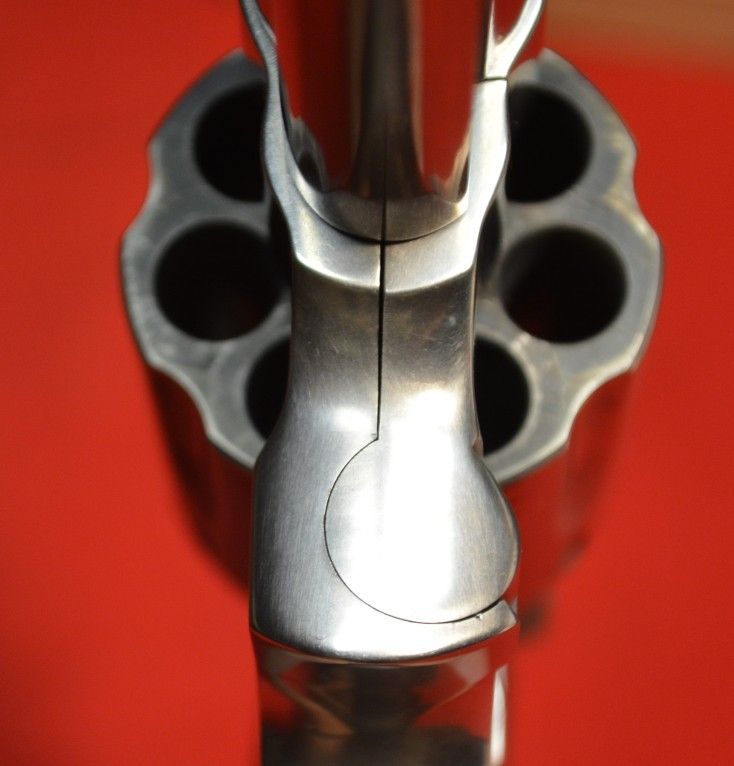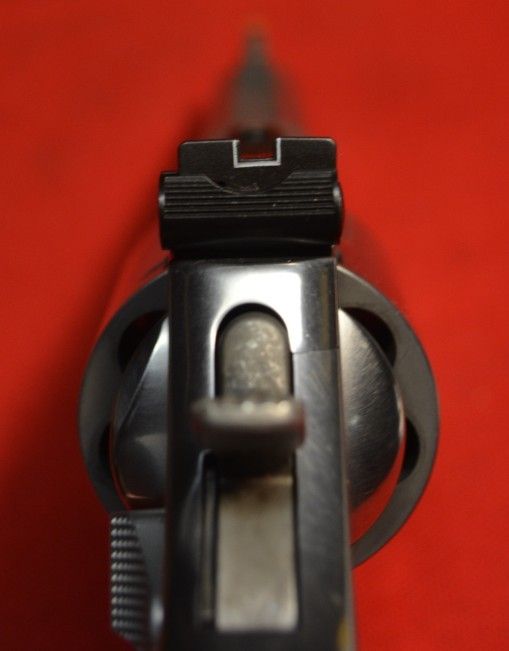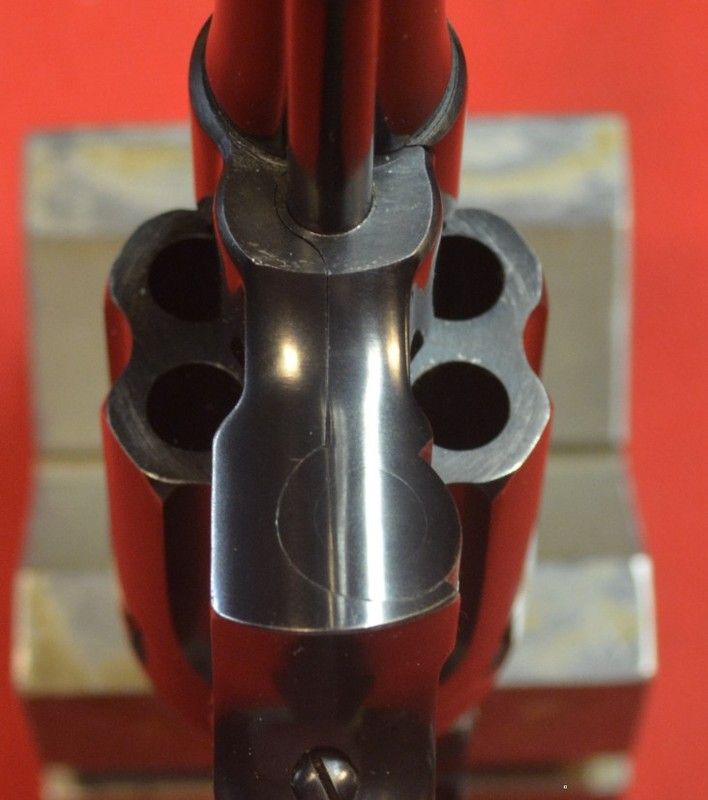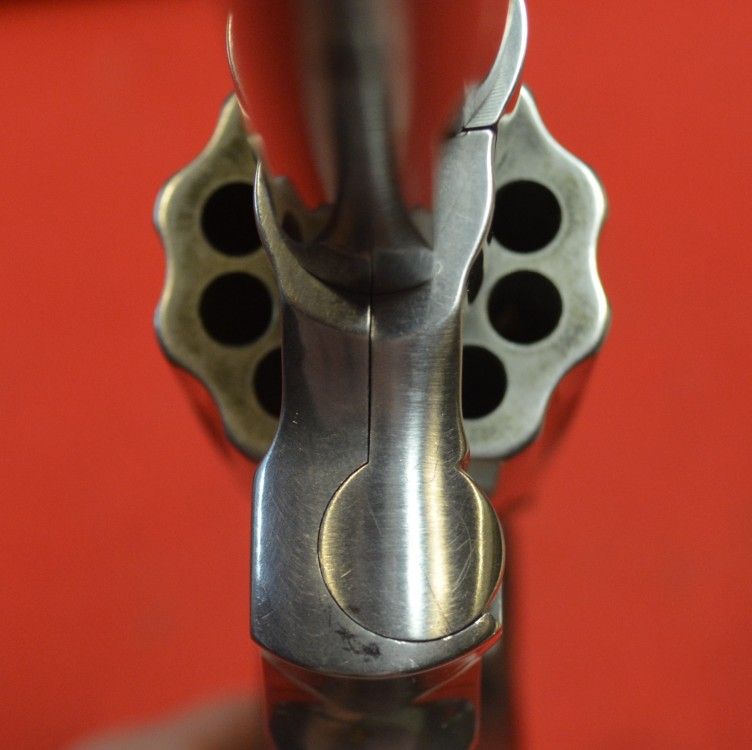You are using an out of date browser. It may not display this or other websites correctly.
You should upgrade or use an alternative browser.
You should upgrade or use an alternative browser.
S &W alignment issues
- Thread starter magnum777
- Start date
NoSecondBest
New member
Troll? Starting a rumor? Tell us what problem you're referring to. Fifty + years of SW ownership and a couple of dozen handguns of their hanadguns and I'm not familiar with the "problem" you're referring to (or trying to create). Reference your source of this "problem" so I can look it up. Someone getting one bad gun doesn't make it "that alignment problem".
I have been shooting S&W revolvers since my firs duty gun a Mod 19 which cost $82.57 at a police supply, and for many years in police pistol competition using a K frame. In those days the barrels were aligned and pinned so there was no problems, in later production the barrels were aligned by machine but never have I heard that misalignment to correct bullet strike was acceptable. I have yet to see a misaligned barrel but I can see where it can happen occasionally in this mass produced era, I personally would not take the word of a telephone answerer and speak to a supervisor while demanding correction of your blatant problem.
Smith warranties every firearm they make so wave your receipt and get satisfaction.
Smith warranties every firearm they make so wave your receipt and get satisfaction.
Driftwood Johnson
New member
Howdy
I suspect this may be what you are asking about. This is a Model 686-6 that I bought brand new in 2015. That is as far as the yoke will shut.

It was not until I noticed I had to shove the rear sight way the heck over to the right, like this, to get it to shoot to point of aim, that I realized there was problem. And yes, I do know how to shoot a revolver, have been shooting them for over 40 years. The problem is with the gun, not the shooter.

I own dozens of S&W revolvers. Yes, dozens. The oldest one was made in 1862, this is the newest one. I have never, ever, seen a yoke that would not close further than this. The problem is, the barrel is slightly canted, and interferes with the yoke closing all the way.
This is the way the yoke should close. It should close all the way, and the joint between the yoke and the frame should be almost invisible. This is a 32-20 Hand Ejector made in 1917. But you don't have to go that far back to see a properly assembled S&W revolver. I have plenty of Smiths from the 1970s and 1980s that were assembled properly.

I had not bought a brand new S&W revolver since 1975. I ran across this one for a good price, and bought it mostly because I do not have any L frame Smiths. Yes, shame on me for leaving the store with it and not noticing the yoke would not close all the way. Now I know better. I doubt I will be buying any more brand new Smiths. This passed QC and went out the door. This would never have been allowed out the door even 15 years ago.
Are revolvers with canted barrels like this still being shipped today? No idea. But this is an example of one that shipped two years ago.
P.S. I checked out a couple of brand new Smiths in a store recently, did not see a yoke that would not close all the way. That is all the empirical evidence I have.
But my photo should give anybody who is interested an example of what to look for. Be sure the yoke closes all the way, the joint should be almost invisible when the yoke is closed all the way.
P.P.S. Here is the yoke on a 617-6 that shipped in July of 2003. I bought it used a few years ago. While not as perfect as the old 32-20, this is acceptable. In truth, with this one the reason the joint is so visible is because the eges were rounded over slightluy before being assembled. In the 'old days' whenever that was, the gun would be polished with the yoke installed, so there was no rounding over of the edges. Today it is probably cheaper to finish polishing the parts separately, rather than in an assembled condition, so some rounding over of edges will be common.

I suspect this may be what you are asking about. This is a Model 686-6 that I bought brand new in 2015. That is as far as the yoke will shut.

It was not until I noticed I had to shove the rear sight way the heck over to the right, like this, to get it to shoot to point of aim, that I realized there was problem. And yes, I do know how to shoot a revolver, have been shooting them for over 40 years. The problem is with the gun, not the shooter.

I own dozens of S&W revolvers. Yes, dozens. The oldest one was made in 1862, this is the newest one. I have never, ever, seen a yoke that would not close further than this. The problem is, the barrel is slightly canted, and interferes with the yoke closing all the way.
This is the way the yoke should close. It should close all the way, and the joint between the yoke and the frame should be almost invisible. This is a 32-20 Hand Ejector made in 1917. But you don't have to go that far back to see a properly assembled S&W revolver. I have plenty of Smiths from the 1970s and 1980s that were assembled properly.

I had not bought a brand new S&W revolver since 1975. I ran across this one for a good price, and bought it mostly because I do not have any L frame Smiths. Yes, shame on me for leaving the store with it and not noticing the yoke would not close all the way. Now I know better. I doubt I will be buying any more brand new Smiths. This passed QC and went out the door. This would never have been allowed out the door even 15 years ago.
Are revolvers with canted barrels like this still being shipped today? No idea. But this is an example of one that shipped two years ago.
P.S. I checked out a couple of brand new Smiths in a store recently, did not see a yoke that would not close all the way. That is all the empirical evidence I have.
But my photo should give anybody who is interested an example of what to look for. Be sure the yoke closes all the way, the joint should be almost invisible when the yoke is closed all the way.
P.P.S. Here is the yoke on a 617-6 that shipped in July of 2003. I bought it used a few years ago. While not as perfect as the old 32-20, this is acceptable. In truth, with this one the reason the joint is so visible is because the eges were rounded over slightluy before being assembled. In the 'old days' whenever that was, the gun would be polished with the yoke installed, so there was no rounding over of the edges. Today it is probably cheaper to finish polishing the parts separately, rather than in an assembled condition, so some rounding over of edges will be common.

Last edited:
"In the beginning," assembly of the barrel to the frame of a Smith & Wesson revolver with proper regulation of the front sight could be done based on regulation, as pinning diminished the importance of final torque.
Once pinned barrels were discarded, torque requirements and sight regulation became potentially in conflict. As a result, some revolvers evaded QA with unacceptably regulated front sights. The problem was hardly endemic, but it was also not entirely unheard of, either.
Where it occurs, the problem can be fixed, but the fix isn't easy. If the barrel torques out short of regulation, careful facing of the barrel shoulder can fix the problem. If, on the other hand, it torques out beyond regulation, the barrel shoulder has to be more aggressively faced, the threads recut, the barrel extension shortened and refaced, and the forcing cone recut.
All of this led to the current design, using an inner barrel (no front sight, so no regulation problem) and an outer barrel shroud (no threaded torque issues). Modern cost cutting.
Once pinned barrels were discarded, torque requirements and sight regulation became potentially in conflict. As a result, some revolvers evaded QA with unacceptably regulated front sights. The problem was hardly endemic, but it was also not entirely unheard of, either.
Where it occurs, the problem can be fixed, but the fix isn't easy. If the barrel torques out short of regulation, careful facing of the barrel shoulder can fix the problem. If, on the other hand, it torques out beyond regulation, the barrel shoulder has to be more aggressively faced, the threads recut, the barrel extension shortened and refaced, and the forcing cone recut.
All of this led to the current design, using an inner barrel (no front sight, so no regulation problem) and an outer barrel shroud (no threaded torque issues). Modern cost cutting.
Sometimes.Does Smith and Wesson still have that alignment problem with their revolvers?
Ruger has the same problem and they never pinned barrels. Even a brand new BFR I checked out at a LGS had the canted barrel.
One more reason I will not buy a revolver sight unseen.
Jim
thibaultfelix40
New member
I read about this stuff. It appears that the barrels on some newer Smiffs I have may or may not be canted. I just can't figure out why I should care.
It is on the internet so it has to be true and it also must be a wide spread problem.you can also Google it and it will come up. I surprised you have not heard about it
Or, you could just do a search on the internet and find out for yourself if there is a legitimate problem with current S&W's and evaluate the legitimacy of the sources. Or, I suppose you can just complain about how the "internet" promotes false problems.It is on the internet so it has to be true and it also must be a wide spread problem.
S&W barrel canting (over or under turned) is a very real QC issue.
It's not a problem in every Smith revolver with a one-piece barrel, but it does show up.
This is no Internet rumor & has been a known issue for some time now.
It's also a legitimate question.
The majority are OK.
And Ruger has been doing the same thing here & there on their revolvers, as noted above.
Denis
It's not a problem in every Smith revolver with a one-piece barrel, but it does show up.
This is no Internet rumor & has been a known issue for some time now.
It's also a legitimate question.
The majority are OK.
And Ruger has been doing the same thing here & there on their revolvers, as noted above.
Denis
Last edited:
Driftwood Johnson
New member
I read about this stuff. It appears that the barrels on some newer Smiffs I have may or may not be canted. I just can't figure out why I should care.
If you think a rear sight cranked all the way to one side, like the one in the photo I posted, in order to get the gun to print where the sights are, is not an issue, well, I don't know what to say.
This is clearly a QC issue, something like that would never have made it out the door when I started collecting Smiths in 1975.
My earliest personal experience with it is the Model 64 I was issued in '80. Shoots 2 inches left at 25 yards.
It was much rarer back then & has increased in the last four or five years.
In a fixed-sight gun, it affects shooting.
In an adjustable-sighted gun, it annoys me if I have to crank the rear waaaay over to either side, and it SHOULD NOT BE THAT EXTREME.
Worth noting the two-piece barrels are not taking over the revolver line & are only used in a small number of Smith revolvers.
And- the new 66 snub I have here, WITH a two-piecer, required me to move the rear blade over markedly to the right.
Not as bad as some revolvers I've had here & not quite as far as DJ's image above, but more than I was expecting.
Denis
It was much rarer back then & has increased in the last four or five years.
In a fixed-sight gun, it affects shooting.
In an adjustable-sighted gun, it annoys me if I have to crank the rear waaaay over to either side, and it SHOULD NOT BE THAT EXTREME.
Worth noting the two-piece barrels are not taking over the revolver line & are only used in a small number of Smith revolvers.
And- the new 66 snub I have here, WITH a two-piecer, required me to move the rear blade over markedly to the right.
Not as bad as some revolvers I've had here & not quite as far as DJ's image above, but more than I was expecting.
Denis
FWIW, old time Colt workers made no secret of the fact that they "adjusted" the windage of fixed sight revolvers by turning the barrels in or out. Another way, reportedly used by both companies was to adjust windage in fixed sight revolvers by clamping the frames in a jig and whacking the barrel with a lead hammer, thus bending the barrel slightly.
Jim
Jim
I don't know about what goes on at S&W these days, the last S&W I bought was pinned barrel, and I stopped looking at their new stuff when they introduced the internal lock.
I did meet one S&W revolver that had a straight barrel which canted after being shot a bit.
back in 80, a friend bought a Model 629, with the long 8 3/8" barrel. also the first unpinned barrel S&W we ever saw. I shot the gun myself, a fair bit, it was very accurate, but the factory wood was very punishing with full house loads.
After a few months, my friend noticed something, the barrel was no longer straight, it canted to the side. Not only did the front sight lean a little, the wide flat rib on the barrel was no longer "level" with the frame, which made it obvious.
He sent the gun back to S&W (this was the Bangor Puta days) it came back with the barrel straight again, and a note from S&W saying there was nothing wrong with it.
My friend then sold the gun...
as to Colt, or anybody else, wacking a gun with a big hammer to get it to shoot straight, so what??
The old saying about things you shouldn't see being made applies here, I think. The old saying said you should never watch laws and sausages being made. I will add to that, guns, and aircraft maintenance.
I did meet one S&W revolver that had a straight barrel which canted after being shot a bit.
back in 80, a friend bought a Model 629, with the long 8 3/8" barrel. also the first unpinned barrel S&W we ever saw. I shot the gun myself, a fair bit, it was very accurate, but the factory wood was very punishing with full house loads.
After a few months, my friend noticed something, the barrel was no longer straight, it canted to the side. Not only did the front sight lean a little, the wide flat rib on the barrel was no longer "level" with the frame, which made it obvious.
He sent the gun back to S&W (this was the Bangor Puta days) it came back with the barrel straight again, and a note from S&W saying there was nothing wrong with it.
My friend then sold the gun...
as to Colt, or anybody else, wacking a gun with a big hammer to get it to shoot straight, so what??
The old saying about things you shouldn't see being made applies here, I think. The old saying said you should never watch laws and sausages being made. I will add to that, guns, and aircraft maintenance.
Many years ago I went through S&W revolver school on two separate occasions, one class we built M 66, 4" and the other 65, 3" revolvers. Within the tool kit purchased for me by my agency was a cylindrical bar of lead approximately six inches long that was used in several of the assembly operations to move metal slightly to attain proper alignment. I cannot recall using it on a barrel but that is a common way experts straighten a barrel during assembly ( referring to WW II Carbine production) that would have no bearing on a canted barrel however.
Unfortunately in mass production the human element is lost and the assembly of a firearm in my opinion should still require that personal touch given by human hands, particularly with revolvers. I guess from the feedback that canted barrels is a problem today no matter the maker but a problem that should be addressed
and the weapon returned for correction.
Unfortunately in mass production the human element is lost and the assembly of a firearm in my opinion should still require that personal touch given by human hands, particularly with revolvers. I guess from the feedback that canted barrels is a problem today no matter the maker but a problem that should be addressed
and the weapon returned for correction.
That was the babbitt.
It can address a canted barrel by whacking the muzzle in the correct direction to change windage POA.
Works on a fixed-sight barrel & just the same way on a canted barrel, although it's not necessarily the best way to correct for cant.
That's how our academy firearms instructor corrected the windage on my 6-inch 66.
It was requiring too much rear blade movement & it was a pinned barrel, so it was easier in that situation to use the babbit to correct alignment.
Used carefully by a knowledgeable hand, the babbitt can make several adjustments to a barrel.
Denis
It can address a canted barrel by whacking the muzzle in the correct direction to change windage POA.
Works on a fixed-sight barrel & just the same way on a canted barrel, although it's not necessarily the best way to correct for cant.
That's how our academy firearms instructor corrected the windage on my 6-inch 66.
It was requiring too much rear blade movement & it was a pinned barrel, so it was easier in that situation to use the babbit to correct alignment.
Used carefully by a knowledgeable hand, the babbitt can make several adjustments to a barrel.
Denis
FrankenMauser
New member
Not sure if I should take offense or roll with it....The old saying about things you shouldn't see being made applies here, I think. The old saying said you should never watch laws and sausages being made. I will add to that, guns, and aircraft maintenance.
When I worked the flight line, one of my nicknames was "hands" ... because I could employ finesse where others used brute force and created more problems. I could bring a delicate touch, patience, and logic to an otherwise insurmountable cluster-'bunch' of tolerance-stacking and out of spec garbage.
But, when the BFH (Big Effing Hammer) was required, I did not hesitate to let it come out to play.
"This thing is F--[not working]. Let's beat on it until it fits or everything breaks!"
Even then, there's an art to using the BFH.
There are three tool groups you'll see on every gunsmith's, or advanced hobbyist's, work bench:
1. A good vise.
2. Brass drifts.
3. Multiple hammers. (Some "soft". Some not.)
